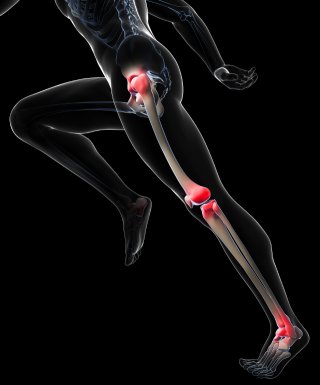
Osteoarthritis (medical terms Arthrosis or Osteoarthrosis) describes an abrasion or wear of the joint cartilage. This can occur corresponding to the age or even above average for the respective age, for example, in high-performance athletes. In the healthy body the cartilage between the bones inside the joints prevents bones from mutual friction. Thus cartilage erosion impairs the joint’s function.
Long-time overload, injuries, displacements of the joints, overweight, certain drugs, but also metabolic diseases can damage the cartilage in a direct or indirect way and thereby cause osteoarthritis. Even though osteoarthritis can pass by asymptomatically, the most common symptoms are load-dependent pain, joint effusion, deformation of the joint, or even joint noises which arise from an increasing friction surface of interlinked bones. Today it is assumed that at the time chronic cartilage damage is recognized by the body the immune system starts to destroy the cartilage actively. The associated inflammation leads to increased symptoms.
Arthritis and Polyarthritis
If the predominating symptoms are about inflammation, the disease is called Arthritis. Arthritis can be caused by mechanically-induced osteoarthritis, but can also have other reasons, such as infections or an accumulation of uric acid (gout). Furthermore, it can also be caused directly auto-immunologically and thereby concern just one or even multiple joints. Some arthritides belong to the general group of connective tissue diseases, triggered by overreactions of the immune system (Primary Chronic Polyarthritis, PCP). Arthritis can appear at any age.
The risks of developing osteoarthritis correlates to the age. About 70 percent of the over 65-year-olds suffer from arthrosis. The most frequently involved joint in the industrial nations is the knee. Osteoarthritis can affect all joints and is the most common joint disease worldwide. In Germany about 5 million people suffer from osteoarthritis.
There are two types of osteoarthritis: The primary osteoarthritis provoked through the disposition of bad cartilage quality and the secondary osteoarthritis, which develops due to mechanical wear, inflammation, or metabolic disorders. In the long term both types are leading to an inflammation of the joint concerned.
Entirely independent of age cartilage damage may arise as a consequence of an injury (for example, at sports) or an accident. By this means also young and particularly sporty people can be affected by osteoarthritis.
Basically osteoarthritis can be classified into four stages: In the first stage a thinning of the protective cartilage takes place as a result of high load. In the second stage the body starts to replace actual cartilage by low-quality substitute tissue. In the third and fourth stage structural modifications of the bones occur which show themselves as cysts (cavity) and osteophytes (bony edges). These alterations develop to minimize the friction surface of two bones, but they often cause limited mobility, pain, and further damage.
Therapy of Osteoarthritis
The therapy of osteoarthritis (arthrosis) has mainly two goals: On the one hand it is the treating physician’s aim to get the patient pain-free, on the other hand a further destruction of the joint and therewith its further functional restriction is wanted to be avoided. That is in particular happening via the suppression of pain perception by the administration of pain relievers, the removal of structures which stress the remaining cartilage, a regeneration of cartilage, or the entire replacement of the joint concerned with a prosthesis.
It is possible to replace the joint by a prosthesis (artificial joint), to stiffen it artificially, or to adjust it, all by means of surgery. If the mainly affected structure is cartilage there is the opportunity to undergo cartilage transplantation.
Stem Cell Therapy of Osteoarthritis
A new treatment method in osteoarthritis is stem cell therapy. Thereby the body’s own stem cells, so-called Mesenchymal Stem Cells (MSC) or Stromal Vascular Fraction (SVF), are obtained out of fat tissue and then directly injected into areas around the affected joints. This method has its roots in veterinary medicine. Stem cells are capable of suppressing the inflammation, modulateing the immune system, and stimulating the regeneration of the affected cartilage. Thus stem cell therapy proposes itself in all types of osteoarthritis (arthrosis) and arthritis.
Because stem cells can also help bones, tendons, and ligaments to regenerate, stem cell therapy is today widely used for the treatment of sports injuries. As a result, in the best case the patient quickly recovers mobility.
In case of chronic and advanced osteoarthritis friction and pain can be relieved and the need of a complex surgery for inserting an artificial joint can be postponed. Nevertheless, in some cases an artificial joint might still be the best choice.
In the meantime there are several studies about the effectiveness of this method in animals and the human. The best prognosis can be achieved in arthritis and joint osteoarthritis if it is not too severe. Often the symptoms and mobility can be improved and the pain alleviated, thus leading to an improvement of quality of life.